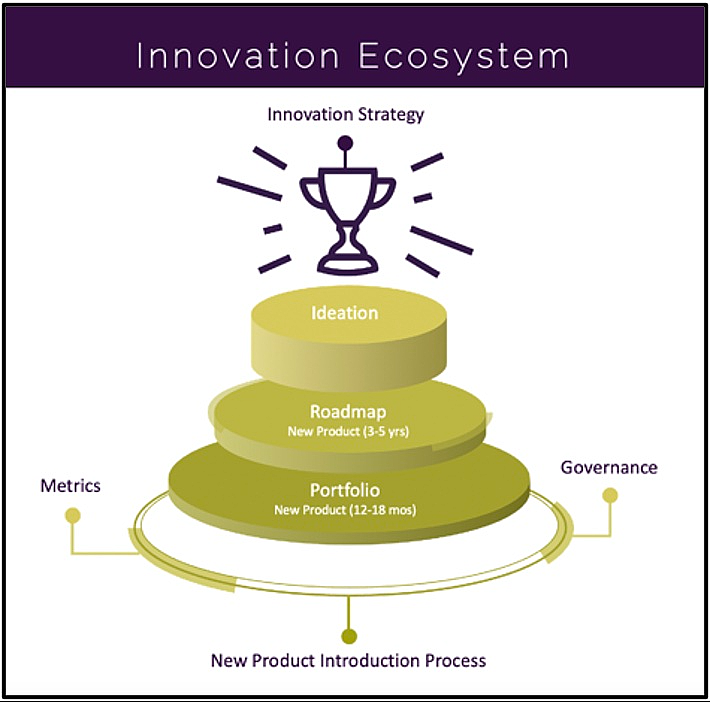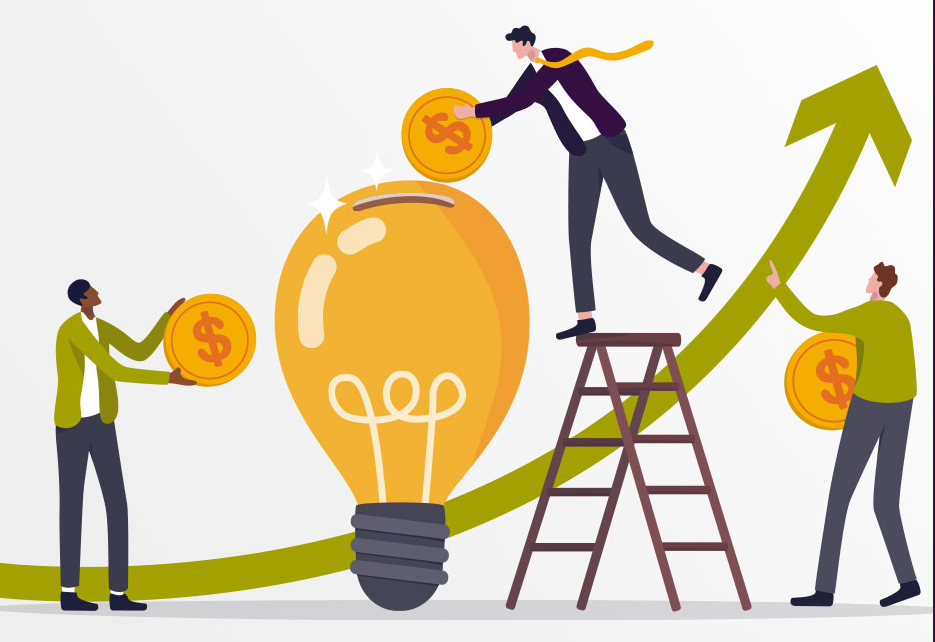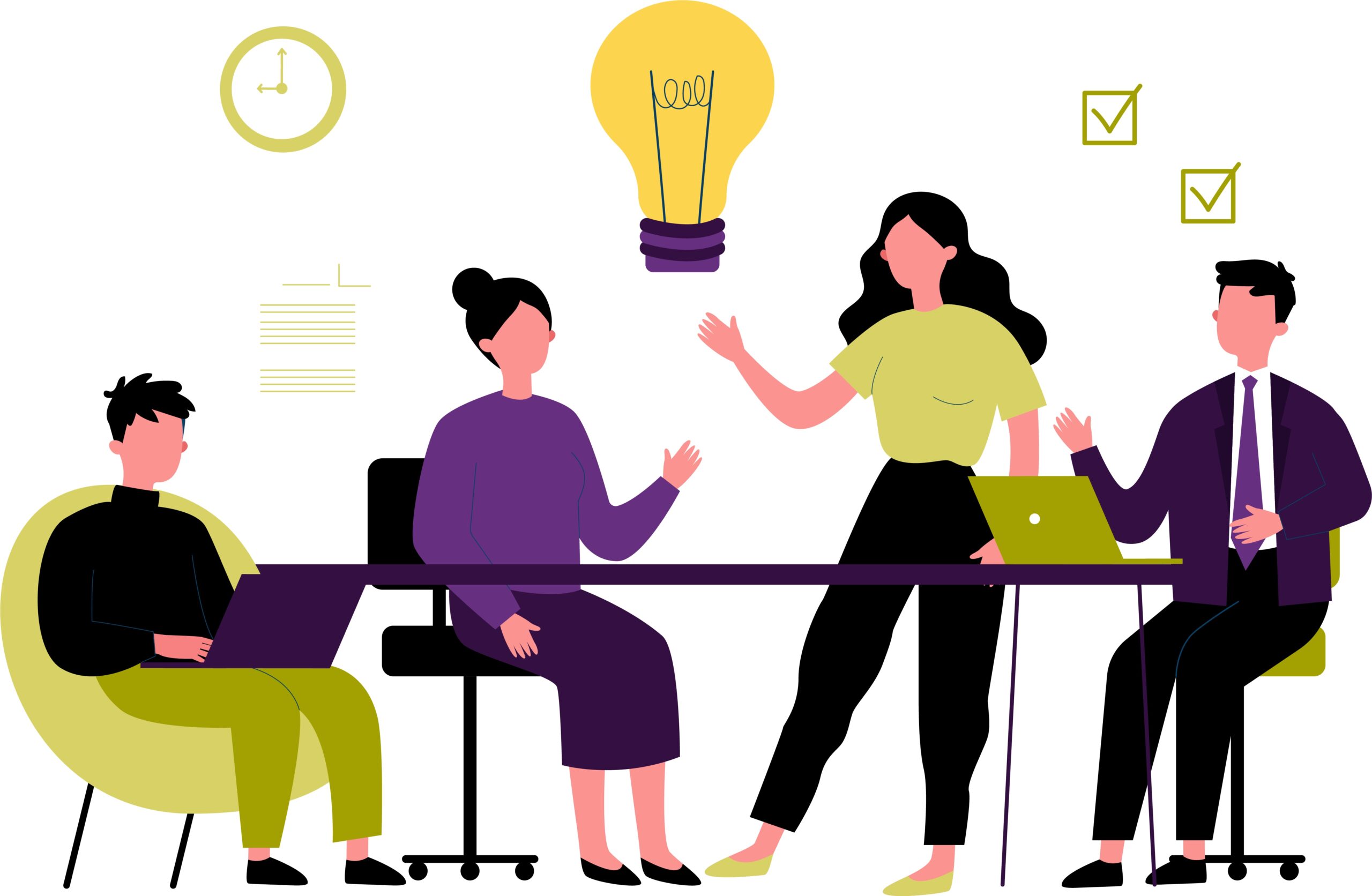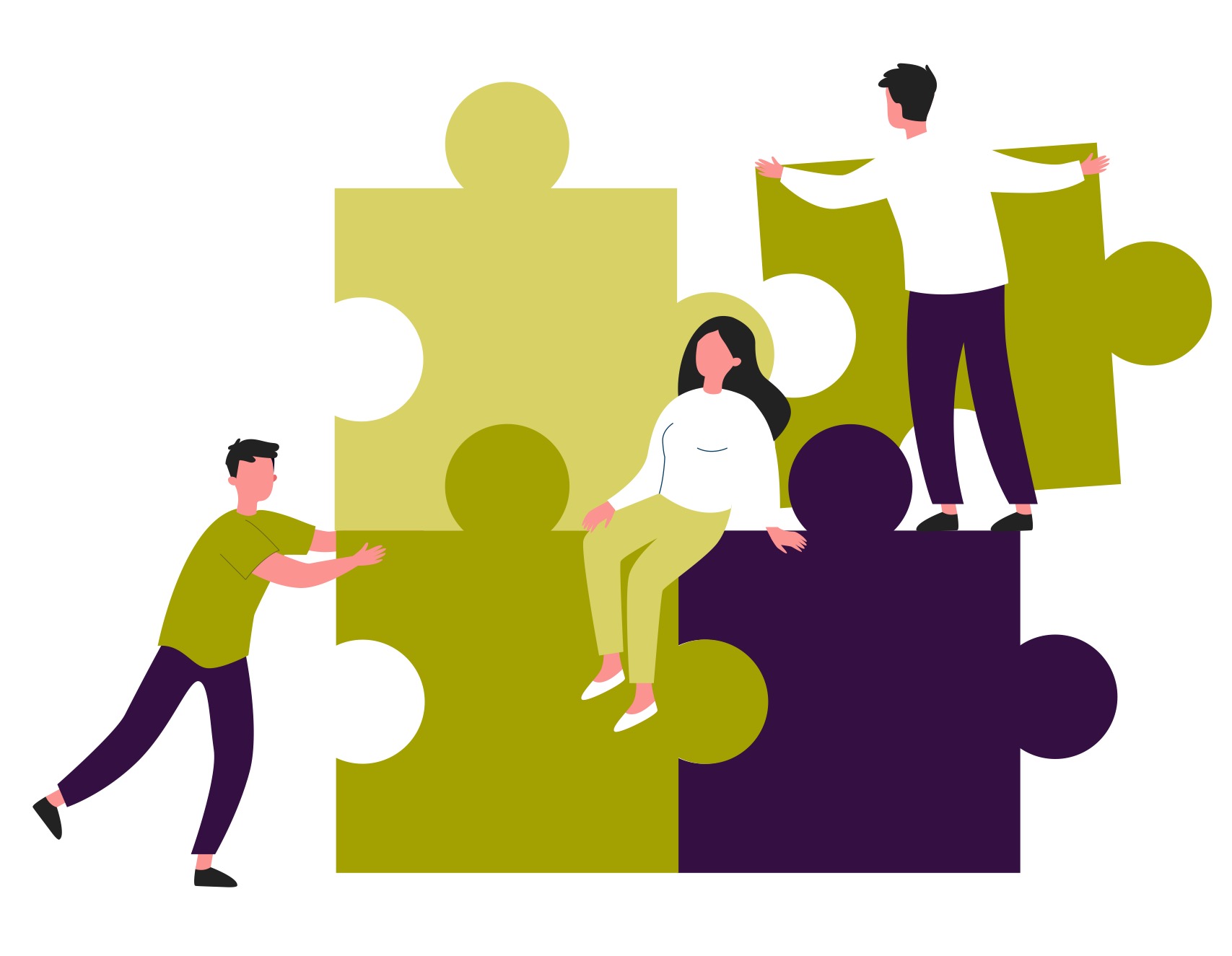Innovation Ecosystem

The Appleton Greene Corporate Training Program (CTP) for Innovation Ecosystem is provided by Mrs. Beauregard MBA Certified Learning Provider (CLP). Program Specifications: Monthly cost USD$2,500.00; Monthly Workshops 6 hours; Monthly Support 4 hours; Program Duration 20 months; Program orders subject to ongoing availability.

Personal Profile
Mrs. Beauregard is a Certified Learning Provider (CLP) with Appleton Greene. Mrs. Beauregard is a leader with 20 years of management experience in large and small manufacturing companies based in Canada and the USA. She provides companies with tools and skills to accelerate their innovation!
After completing her MBA in Business Management at Université Laval in 2002, Mrs. Beauregard quickly turned to product management. She then completed her training in product management and development, project management, market analysis and performance indicators with the Product Development and Management Association (PDMA) by obtaining the New Product Development Professional (NPDP) certification in 2007.
Her career drives her later to build on her strengths in program management, portfolio and organization by leading and contributing to the programs and project offices. To find more and more tools to ensure the performance of the programs entrusted to her, Mrs. Beauregard completed her Green Belt Lean Six-Sigma certification in 2018.
Her experience in innovation management allows her to mobilize teams, structure tasks and define proper roles, so everyone understands expectations and contributes to the height of their abilities while learning!
Recognized for her empathetic leadership, ability to solve complex problems quickly and efficiently, and bringing innovative business models, Mrs. Beauregard has contributed to the success of many product developments and partnership projects, optimizing internal processes and clarifying roles to achieve the goals entrusted to her.
To request further information about Mrs. Beauregard through Appleton Greene, please Click Here.
(CLP) Programs
Appleton Greene corporate training programs are all process-driven. They are used as vehicles to implement tangible business processes within clients’ organizations, together with training, support and facilitation during the use of these processes. Corporate training programs are therefore implemented over a sustainable period of time, that is to say, between 1 year (incorporating 12 monthly workshops), and 4 years (incorporating 48 monthly workshops). Your program information guide will specify how long each program takes to complete. Each monthly workshop takes 6 hours to implement and can be undertaken either on the client’s premises, an Appleton Greene serviced office, or online via the internet. This enables clients to implement each part of their business process, before moving onto the next stage of the program and enables employees to plan their study time around their current work commitments. The result is far greater program benefit, over a more sustainable period of time and a significantly improved return on investment.
Appleton Greene uses standard and bespoke corporate training programs as vessels to transfer business process improvement knowledge into the heart of our clients’ organizations. Each individual program focuses upon the implementation of a specific business process, which enables clients to easily quantify their return on investment. There are hundreds of established Appleton Greene corporate training products now available to clients within customer services, e-business, finance, globalization, human resources, information technology, legal, management, marketing and production. It does not matter whether a client’s employees are located within one office, or an unlimited number of international offices, we can still bring them together to learn and implement specific business processes collectively. Our approach to global localization enables us to provide clients with a truly international service with that all important personal touch. Appleton Greene corporate training programs can be provided virtually or locally and they are all unique in that they individually focus upon a specific business function. All (CLP) programs are implemented over a sustainable period of time, usually between 1-4 years, incorporating 12-48 monthly workshops and professional support is consistently provided during this time by qualified learning providers and where appropriate, by Accredited Consultants.
Executive summary
Innovation Ecosystem
Today’s consumers are exposed to tons of new products. According to a Nielsen study, around 57% of recent survey participants stated that they had bought new products during their last trip to a simple grocery store. That is only in one segment. What about the whole CPG industry? How can you stand out with recurring launches of relevant new products? You need to stay top of mind for your customer through a sustainable new product roadmap.
That is easier said than done, and the pressure of recurring new product launches makes more than one team break. Leaders are overwhelmed by the complexity of aligning all the variables required for:
● Finding the golden ideas;
● Building a solid product concept;
● Developing a product that meets the cost and the production requirement while being appealing to the customer;
● Launching the product on a limited budget but still reaching the required awareness.
This entire program is known to reduce time-to-market by 20-25%, improve internal alignment and structure resources to ensure a sustainable pipeline of new products.
This program can help you build a structured new product development ecosystem that will support the short-term requirements while allocating resources to big ideas that will drive more incremental sales and make your competitors jealous.

Solid Foundation
The program starts by building a solid foundation for the overall ecosystem. A straightforward process maps the directions and the steps that the team needs to go through. It clarifies who needs to be involved to avoid conflict and prevent rushing ahead too quickly toward execution. Decision-makers need visibility of the concept and control over when spending will happen and when new resources should be invested. Return on investment versus risk is an essential aspect of the process that supports healthy cash flow planning while simultaneously developing new products. This program will accompany the definition of governance, the decisions required, and the information needed to support them.

Building a solid foundation with a phase-gate process also supports the consumer-centricity of new products. It has been proven that a new product developed around a consumer need instead of a white space in the company’s product portfolio has a significantly more chance of success, achieving the targeted sales volume. If the product solves a real consumer problem, the consumer will adopt the new product and most likely repurchase it. The innovation team should focus on making life easier for the consumer. The customer is the expert in his reality, but the innovation team is the expert in designing solutions. Developing a relationship with the consumer and asking questions about their needs are much more significant indicators of success than having the customer test the product prototype again and again. This Innovation Ecosystem program will provide tools to support consumer-centric product development with a transparent step-by-step methodology.

Incremental Sales
Launching new products that will drive incremental sales is exciting but renovating and updating the existing product range is also part of the innovation ecosystem. Refreshing the recipe/formula, optimizing costs, and opting for more sustainable packaging are all excellent reasons to work on your existing products. The workload of the innovation team needs to be efficiently divided between renovating existing products, looking for ways to enhance the product offer, and generating breakthrough ideas. The balance of the new product portfolio, strategy and development roadmap is another critical aspect that will be addressed in this program.

Once the planning is completed, it is time to tackle the new product concept and channel the team’s efforts through a structured framework to focus on the consumer. Testing assumptions, validating the market, understanding where the competition plays and building a unique value proposition are where the innovation team will start the actual work. With a solid new product concept on the table and a compelling business case, the strategy and the financial analysis will be presented to decision-makers before moving to product development, involving the cross-functional team or spending more dollars and allocating more resources. The business case represents the pivotal point between the theoretical product concept and the reality of its fabrication. It is also the transition between spending money on market studies and capital assets. Since it is critical to have endorsement from the executive before those investments, the business case needs to be thought through, concise with key messages, solid financial analysis, and rehearsed! As decision-makers face many presentations in a week, they must understand what is expected of them, avoid drowning themselves in tons of data and focus on the relevant information. Executive presentations are not commercial presentations, some principles need to be followed, and this program will support your team in developing the required skills for a solid Business case presentation.

Team effort
In most companies, the challenge of too many projects and insufficient resources are recurring. This program will provide prioritization tools to communicate the most critical opportunities for the business. Decision-makers must decide when it is time to outsource, get more people on board or postpone less lucrative opportunities. Having a rationale behind the business priority also helps manage pet projects and not-so-urgent requests from sales.
This program will also address the challenge product concepts face when the manufacturing and transformation reality hits. That critical step coincides with the project’s leadership transfer from the conceptualization team to the operation team. Communication challenges may occur between the must-have to fulfill the consumer needs versus the nice-to-have that might be left off. But it also raised more opportunities to improve the product concept. The cross-functional team must meet a target timeline and negotiate to achieve the expected cost and margin.
While all efforts are invested in making the winning product concept a reality, the marketing team needs to ensure the consumer will notice it. Some companies have millions to invest into supporting a launch, others a few thousand. Start-ups are the best example of success on a tight budget: they have a refined message, clear persona, and creative way to reach it. This is what will be covered in this program: The launch strategies, objectives, and tactics, as well as key metrics, will be clearly defined to reach the largest audience.

With the established foundation, it will be time to build an innovation strategy and understand the innovation capacity versus actual needs to achieve your company’s growth goal. You were cropping numbers to understand the reality of past launches versus expectations toward future launches. Review the allocation of resources and optimize them to accelerate the development of more incremental products. After crunching the numbers, the next question is where the business wants to grow, what will be the pillars of the future roadmap for new products and what resource allocation to win at understanding your consumer. This program will dive deeply into your business capacity, expectation, and exciting future.

Essential Skillset
Innovation in the context of manufacturing and CPG is overlooked in many aspects in the available literature or training: The IT sector captures a significant amount of attention in the subject. Beyond this entire ecosystem, some key competencies are essential to address in this program: Innovation leadership, cross-functional team management, and innovation project management. With over 20 years of experience in the industry, I will be happy to share my thoughts and wisdom to sharpen these skills and provide context to the underlying challenges that accompany innovation and manufacturing.

Finally, this program closes with the post-mortem. Like any sustainable process, it is essential to challenge what should be done to improve it and enable future projects to be tackled with an improved and adapted system. The market fluctuates, the business evolves, and the process needs to improve to represent this reality. By having a mapped, understood, experimented, and communicated process, any changes would be easier to implement.
That whole program reduces the time to market by 20%-25%, improving internal alignment and structuring resources to ensure a sustainable pipeline of new products.
If you play to win, this program will make sure you do!
Curriculum
Innovation Ecosystem – Part 1 – Year 1
- Part 1 Month 1 Optimal Ecosystem
- Part 1 Month 2 Customer-centric
- Part 1 Month 3 Phase Gate
- Part 1 Month 4 Decision making
- Part 1 Month 5 Governance
- Part 1 Month 6 Product Concept
- Part 1 Month 7 Business case
- Part 1 Month 8 Product development
- Part 1 Month 9 Launch Strategies
- Part 1 Month 10 Value Proposition Canvas
- Part 1 Month 11 Value of messaging and the product itself
- Part 1 Month 12 Product Management
Innovation Ecosystem – Part 2 – Year 2
- Part 2 Month 1 Product roadmap
- Part 2 Month 2 Portfolio Prioritization
- Part 2 Month 3 Executive Presentation
- Part 2 Month 4 Innovation Strategies
- Part 2 Month 5 Team Management
- Part 2 Month 6 Innovation Leadership
- Part 2 Month 7 Innovation Project Management
- Part 2 Month 8 Post-Mortem
Program Objectives
The following list represents the Key Program Objectives (KPO) for the Appleton Greene Innovation Ecosystem corporate training program.
Innovation Ecosystem – Part 1 – Year 1
- Part 1 Month 1 Optimal Ecosystem – Optimal new product development is a balanced ecosystem between multiple components – process, roadmap, portfolio, and strategy, to name a few. It’s a balanced ecosystem where the whole equilibrium collapses if you invest too much in one aspect and neglect another. Before starting our journey into the optimal Product development Ecosystem, it is necessary to build shared vocabularies and concepts that will be able to build on:a. Start with Process and Governance; b. Link to Business Strategy; c. Clarify teams’ roles; d. Cross-functional steering committee; e. Lead complexity to simplicity; f. Test; g. Manage passion.
- Part 1 Month 2 Customer-centric – Consumers are the experts on their own needs. Your team is the expert on your product and market. While developing a new product, it is vital to put the customer at the center of our development and decision-making. Today’s consumers are solicited by hundreds of new products every month. Understanding what will make them purchase your product is critical. By targeting surveys and other research toward the target consumer, the innovation team will develop a unique competitive advantage: a. Product centric vs customer-centric; b. Consumer-centric vs consumer focus; c. Benefits; d. Why new product win; e. How to migrate to customer-centric; f. Open conversation with your consumers; g. Develop a competitive advantage.
- Part 1 Month 3 Phase Gate – The new product development process is known as a Stage-Gate®: the adaptation of project management applied to a standard process to ensure traceability of the decision-making, clear role definition and allow improvement. It will become the base of your new and improved Innovation Ecosystem: a. Stage-Gate ® from Bob Cooper; b. Separate strategic vs operation; c. Differentiate decision-making from execution; d. Process management vs project management.
- Part 1 Month 4 Decision Making – Once the work is clearly defined, it is time to take control of the spending and mitigate the risk through appropriate decision-making with the relevant decision-makers at the right time. Timing of the decision-making makes a considerable difference in the efficiency of the process and the engagement of the team: a. When to make a decision; b. How deciding is better than not making a decision; c. Allocate $ and resources; d. Expenses management; e. Risk management.
- Part 1 Month 5 Governance – Clarifying everyone’s roles is a critical element in engaging cross-functional team members. It is essential to separate the decision-making on crucial details from the project update and risk mitigation. Transparent governance is a critical success indicator of the freshly designed process: a. Who needs to be involved when; b. Workstreams and decision makers; c. Roles – RACI.
- Part 1 Month 6 Product Concept – New products start with a market opportunity that will evolve into a product concept that fulfills consumer needs. Easier said than done. Multiple tools exist in the market to assist you in developing your concept. Once again, it is crucial to understand your consumer before developing a solution. Consumers don’t know what they need, but they can inform you of what their problems, motivations and needs are: a. Value proposition Canvas; b. Lean Canvas; c. Talk with consumers; d. The consumer doesn’t know what they need; they know their problems; e. Don’t test the concept; test your assumptions; f. Pivot your concept; g. You will not change consumer habits; h. You need to make their life easier.
- Part 1 Month 7 Business Case – Once invested, efforts into understanding your consumer conducted the development of a solution. It is time to gain alignment from decision makers and present the project through a complete but concise Business Plan. The business case is the pivot point between the conceptual development, supported by secondary and primary market research, and the actual prototyping development and spending a more significant amount of money. It also allows the decision makers to control the spending by gaining visibility of the risks/rewards the opportunity represents: a. Needs to attach an idea to business needs and strategy; b. Ensure you are contributing to the company’s building blocks; c. Understanding the market – trends; d. Position competition on a map – 2×2 or Bubble graph; e. Who is your consumer, your persona? ; f. What is your concept, and how will it fulfill your consumer needs; g. Will this bring enough money? ROI, Break-even point; h. What are the conditions for success and critical path?
- Part 1 Month 8 Product Development – The exciting yet complex phase of the product development process occurs when the cross-functional team works together to deliver a solution to the targeted consumer’s problem successfully. The innovation team develops a product concept that hits all the ideal cases. Still, the development of a prototype, minimum viable product, testing, and manufacturing process are where reality meets the perfect concept. Concessions need to be made to be able to hit the cost target: a. Prototyping and testing; b. Process, material, design; c. Patent; d. Messaging; e. DFM and optimization; f. Forecasting sells vs forecasting supply; g. Golden samples; h. Ramp-up vs Mass production; i. Client presentation pitch.
- Part 1 Month 9 Launch Strategies – Commercialization regroups many aspects, from the marketing 4Ps to many tactical details that will make the new product successful in the market. While the development team works on bringing the product concept to life, the marketing team must solidify the launch strategies. Once again, it is essential to revert to the consumer motivation and shopping habits and cross-reference it with the unique value proposition of the product concept: a. Risk evaluation; b. Perfect timing; c. Messaging development and UVP; d. Value of pre-launch; e. ATAR – Awareness – Trial – Availability – Repeat; f. Geography or privileged partners; g. Price positioning and price strategy; h. Metrics.
- Part 1 Month 10 Value Proposition Canvas – Essential tools to make sure your team understands your consumer from the beginning. Before spending too much time developing something, the customer doesn’t care. It is essential to understand their needs and their triggers. A canvas to challenge your assumptions and pivot your product concept if required: Offer a framework to address the ideation or inspiration alignment with what the consumer cares about. I use that tools to start building assumptions about our consumers that will later be validated with surveys, focus groups or face-to-face meetings. It also allows the conversation to remain on the consumers’ needs before moving too quickly to the solutions and features. Once that triangulation is evolving enough, the Value Proposition Caneva allows you to formulate how to succeed at helping your consumer. a. Help to focus on your consumer; b. Define your market segment/persona; c. Understand their problem; d. Define what works and what doesn’t work for them; e. Research solution; f. Tests assumptions.
- Part 1 Month 11 Value of messaging and the product itself – Few key innovators are not innovators… They took someone else’s invention and packaged it to deliver something appealing to the consumer. What may differentiate your product from the competition is how you provide it to the market, which demonstrates that the importance of the messaging is often underestimated: a. Make sure you understand the problem you are trying to solve; b. Understand your persona; c. Make sure you are not talking to a niche; d. Master your competition landscape: their UVP and vocabularies; e. Explain the benefits; f. Use your consumer vocabulary.
- Part 1 Month 12 Product Management – To ensure an optimal innovation Ecosystem, it is essential to implement Best Practices in terms of Product Management. Your product lifecycle is key to managing resources and keeping your product line relevant in the market: a. Define product platform; b. Product lifecycle; c. Type of product vs type of project; d. Variety of projects: Renovation, Incremental, differential, breakthrough; e. Product Manager role; f. Close to strategic orientation; g. Support Product management; h. Product Management vs Brand Management.
Innovation Ecosystem – Part 2 – Year 2
- Part 2 Month 1 Product Roadmap – Once the product analysis is done, it is time to look at the product launch cycle, the best timing to launch a new product, and the capacity (dollars and resources) to develop your new product and renovate existing products: a. Understand the vision of the new product launch; b. Plan for lifecycle management and product renovation; c. Prioritized launch and prioritized budget; d. Manage resource availability for different product dev phases.
- Part 2 Month 2 Portfolio Prioritization – In any organization, the challenge around new product development projects is allocating appropriate resources. The decision-makers tend to approve every new product presented, as the team that pitches them is convinced of the opportunity. Unfortunately, there need to be more resources (human and financial) to be able to deliver all of them. That is where a realistic priority, based on rational criteria, helps to identify the real opportunity for the companies: a. Strategic bucket; b. Scoring model: Weighted average criteria; c. A score doesn’t worth anything if not in a context; d. documented decision-making, not emotional; e. Allocate resources to the most crucial project for the company.
- Part 2 Month 3 Executive Presentation – The executive in a company makes hundreds of decisions every week, if not every day. When it’s time to get alignment from the decision-makers, it is essential to have a solid presentation highlighting the key messages while telling a story. To achieve a positive response, the presentation and the presenters need to be well prepared with a concise presentation that highlights the critical information to entertain the conversation around the strategic elements actively: a. Start with an exec summary; b. Clearly state your objective, your storyline and your recommendation; c. Have a clear pitch, know your compelling arguments; d. Use title and subtitle; e. Share information and insight, not data; f. Leverage graphics, not tables with numbers; g. Which graphics to make the data speak; h. Start with hard data and finish with softer arguments; i. Rehearsal and support.
- Part 2 Month 4 Innovation Strategies – Short-term opportunities can fuel your innovation pipeline for a while. Still, building a long-term vision of your product development is essential, starting with assessing the company’s innovation capacity vs the innovation ambition. Embed in the innovation strategy is the Product strategy, Commercialisation timing and so on: a. Growth objectives: organics vs innovation; b. Capacity: Innovation Throughput; c. Capacity: New launches vs renovation and extension; d. New product launch timing/requirement; e. Product Strategy; f. Product lifecycle.
- Part 2 Month 5 Team Management – A key element to succeed in innovation is the ability to work and lead a cross-functional team, where each player has their constraints and timeline as part of their daily metrics. Keeping the matrix team engaged is critical, but that doesn’t happen without some personal and task conflict that needs to be managed, and expectation that also needs to be clearly communicated: a. Role definition; b. Task vs personal conflict; c. RACI; d. SME; e. the value of the Gantt Chart and critical path; f. Communication and touch point; g. Tools.
- Part 2 Month 6 Innovation Leadership – Being an innovation leader requires a unique skill set. Building a team around a solution instead of a vision makes a real difference in the conversation. Having the ability to translate one needs into another’s reality is a challenge. Complex situations, multiple variables and tough decisions are in the path of the Innovation Leader: a. Focus on the solution, not on the vision; b. Lots of politics, expectations, and interpretations; c. Influence: understand who your allies are; d. Being data ; e. Having a good sponsor; f. Who is the Innovation leader? ; g. It might evolve along the process lifecycle.
- Part 2 Month 7 Innovation Project Management – Another key role in succeeding in new product development is the Project leader. An innovation project is far from being unidirectional. Pivoting a concept may end up influencing the whole business model. The deliverables are unclear from the get-go, and many grey zones and undefined timing need to be reflected in the Gantt Chart. Mastering the critical path and communicating through an efficient dashboard are a few of the skills your Project manager will need to stay within target timing – budget – resources to deliver the expected product: a. Agile, sprint; b. Live in the grey area; c. Not linear; d. Active and regular communication; e. Managing risk; f. Focus on the solution, not the tasks; g. Deliverables and engagement.
- Part 2 Month 8 Post-Mortem – Like any efficient process, adjusting as we go, celebrating success and assessing what can be improved in the next round is essential. Not all new product projects are the same, but the bones that support them must be clear to all contributors. Distinguishing the project specifically from the process is the first challenge in the Post-Mortem meeting. But no process is perfect; what is essential to do is to improve it regularly instead of storing it and improvising: a. Pizza size team; b. Different timeline; c. Key success indicators; d. Process: ongoing improvement; e. Technical: develop tools; f. People: develop skills; g. Product sells through, cost, revenue vs expectations.
Methodology
Innovation Ecosystem
Developing a new product might seem straightforward on the business’s operation side. But a big part of the challenge sits in creating the right product. Not just adding features to existing ones but developing a new and solid concept that will bring new incremental sales, help acquire new consumers or position the company on a new market. A few years ago, looking at the product portfolio and comparing it with the market and competition was enough to fulfill with space… but nowadays, consumers are more demanding, and the market evolves more quickly than ever. Therefore, having a consumer-centric approach with a well-articulated process is key to success.

Foundation
This program will help your company build a solid foundation for a product, from idea to launch. The foundation lies in understanding the process, roles, and expectations of the individuals concerned and reassuring the decision-makers on spending and risks. Managing the process goes hand in hand with project management. It’s one thing to understand the steps and deliverables; it’s another skill set to ensure that it will happen within the expected timeframe. To avoid delays and surprises, decision requirements must be elevated appropriately before spending money, investing more resources, or when a significant fallback arises. A major constraint in the CPG world is the window for presenting and listing your product with the tier-one client.

Build Product and Messaging
Once the foundation is established, building a solid product concept is critical. With different proven tools, such as the Value proposition Canvas, Lean Canvas, and Voice-of-customers, your Front-end team will learn how to interpret market trends and pioneer new product concepts. The key to winning new consumers in today’s market is making their lives easier. Therefore, it is essential to understand your consumers and how to talk with them to understand their motivation, needs and objectives. After, and only after, the consumer part is mastered, your technical team can start working on solutions, building prototypes, and validating with consumers that the proposed solution does make their life easier.
While your technical team works on a solution, your marketing team works on the messaging: how to ensure the consumer gets it. Your consumer should understand quickly how the solution you want to put on the market will make their life easier. That’s the key to repeat purchasing. You can have the best production or solution in the world, but if it is not commercialized using the consumer vocabulary, it will remain on the shelf and have a very short lifecycle.

Executive presentation
For the executive team to mitigate business risks and allocate resources to the most promising idea or project, they need to be presented with a business case. The business case needs to go beyond financials; it should allow the team to explain their strategy. Building a solid business case that aligns the products into the strategic landscape of your company, the market and how it will fulfill a consumer need is an art. It must be concise enough that the key messages are not lost in the details but detailed enough so that the leadership team can understand what they are getting themself into.
Presenting the business case is the synonym for pitching to the leadership: if you have a good story, you will be allowed to move to the next phase. If you can articulate your ideas and answer questions efficiently, you might be sent back to your drawing tables or, worst asked to work on something else.

Strategic Product Management
After the projects are moving along, it is time to be more strategic about your New Product development approach. Launching products regularly will be less stressful and more predictable if you plan a sustainable product road mapping. Understanding the lifecycle of your current product portfolio will help to know when launching a new product vs renovating a successful product, improving its value to consumers, or repositioning them on the market to ensure it is priced strategically.
Product Management ensures a healthy bottom line and drives your product development planning. Translating your product vision into a product Roadmap will contribute to communicating it as it talks to each product platform or product technology separately and shapes their future in terms of renovation and innovation.
A more robust product portfolio will demonstrate how your Innovation Team can support your company’s strategic growth. It’s one step further into a strategic innovation ecosystem: which part of your company growth is supported by new products in the mid and long term. It will also help plan investments, resources, and contributions to the top and bottom lines.

Secret in the soft skills
Developing and implementing a strategic Innovation Ecosystem requires more than just technical skills. It also means that your team must collaborate internally, with cross-functional teams, and externally with suppliers and customers. Innovation and new product development are strategic inputs to the company and must be handled carefully. The ability to present relevant information to the key stakeholders at the proper time and the ability to influence and manage matrix teams are just a few of the soft skills required to succeed.
This program will guide your team through every step of building the foundation up to the strategic approach and skills development, so your company can successfully launch new products on the market every season and support your growth with incremental sales.
Industries
This service is primarily available to the following industry sectors:

Consumer Goods
Consumer Goods cover various manufactured products, from foods to sports goods, apparel to furniture. One of the biggest challenges companies in the CPG world face is Trust. Trust from customers towards them, towards their brand. Consumers evolved, being more demanding and expecting transparency from manufacturers. They expect social engagement, environmental responsibilities, and personalized services. The mass market needs customization! Therefore, it is even more critical than ever to put the customer at the center of the company’s interest.
It provided the context for the enterprise to open conversations toward new business models. It generates opportunities to add services to product consumption and reinvent themselves.
While facing the more demanding consumer, CPG Manufacturers also meet lots of pressure from their supply chain: increasing cost to longer lead time adds stress to their bottom line. From an operational point of view, Manufacturers also face a shortage of qualified labour in critical positions, putting pressure on gaining efficiency and implementing technologies to eliminate low-added-value tasks and keep employees motivated and engaged.
Canada
According to Industry Canada, the CPG industry accounts for one-third of Canada’s manufacturing GDP and 40% of employment. Exportations accounted for $16 billion in 2021, mainly sent to the USA. Importations were estimated at $17 Billion according to Kevin Grier’s 2021 CPG Trade Wrap-Up Study. Different sources estimate the CAGR to be 5-6.5% over the upcoming years.
USA
The US Department of Commerce estimated the CPG industry worth $635Billions in 2019. The market is fiercely competitive, mainly dominated by large manufacturers, which allocate many dollars to advertising and keeping consumer attention. The estimated CAGR is around 3% until 2028 for the USA market, according to Digital Journal.

Food and Beverage
Canada
Worth over $117.9 billion as of 2019, the food and beverage processing industry is the second largest in Canada. According to the Agri-Food Canada website, food and beverage processing and manufacturing represents 17% of the overall manufacturing sectors and up to 2% of the GDP (Gross Domestic Product). Canadian can proudly state that 70% of all the food and beverage producers in Canada are sold within our frontiers, with the most significant exportation going to the USA.
In 2021, 90% of food and beverage processing companies registered less than 100 employees. Therefore, SMBs can be very innovative but might welcome some help and support to gain structure and agility in their product development.
USA
Like what we see in Canada, in the Manufacturer’s outlook survey from the National Association of Manufacturers, for the 3rd quarter of 2022, 78.3% of business experiment with supply chain issues, with only 10.3% foreseeing upcoming improvement. The labour shortage and increased material and logistic cost pressure were also their top priorities. 63% expect a recession in the forthcoming months.
State of the market
Like other businesses, the pressure of costs and the shortage of competent employees are significant stress that Food and beverage companies need to address. It translates into high employee turnover and a solid process to transfer knowledge and avoid learning loss during those transitions. The hectic supply chain also makes the planning more challenging, and a riskier decision needs to be made. Manufacturers are looking for specific components but face the situation where the suppliers can offer way more than required, or the manufacturer must wait months for the subsequent deliveries.
The market is also accelerating; consumers are more demanding and have more refined requests, generating more market niches to be exploited. Consumers are expecting more from their favourite brands. Social media magnify every good initiative or misstep. Authenticity and social engagement are now assumed to be based on brand identity. Open communication with consumers and involvement in product development is a definite underlying trend to narrow down unfulfilled needs and create differentiated new products.
Strong underlying trends for health and environment-friendly practices and habits, which support local food transformation, are intuitively associated with being more healthy, less transformed, and having less carbon footprint.
The 2020-2021 pandemic hugely impacted food processing, manufacturing distribution, and business models. The transition to the new normality rechallenged the direct-to-consumer business models, as consumer needs evolved continuously and at an accelerated pace. There is no «return to normal» after the pandemic. Consumers adopted a new way of consuming food; the pandemic lasted long enough for consumers to develop new habits and adopt new values. Food processing and manufacturing companies must adapt to the latest consumer needs, not the other way around. That’s where the need to innovate, not just new products, but on a deeper level, becomes key to survival in the long run.
Locations
This service is primarily available within the following locations:

Great Montreal Area, Quebec, Canada
Montreal is the economic capital of the province of Quebec, the largest city of the province and the second largest in Canada, after Toronto, with over 4,2 million people. Composed of 16 municipalities and 19 boroughs in the City of Montreal, it is the driver of Quebec’s economy, and significant investments are made to support entrepreneurship. Manufacturing and transformation are the second largest industry, with over 500,000 direct jobs, a GDP of 14% and contribute to 90% of exportation. Even though AI and high tech are taking a big part of the economic weight, manufacturing, mainly food processing and transformation, is a significant part of the economy.
A recent report from Montreal International state that food processing is a crucial industrial sector with over 1500 companies, mainly small and medium processing business. The region benefits from many universities, colleges, and multiple R&D centers. The low cost of living is evaluated at a 23% cost advantage over other big North American cities. That translate into competitive salaries in many different sectors. Moreover, it is a strategic location for manufacturing entrepreneurs with easy access to energy sources and attractive tax treatment for the manufacturing industry (without mentioning the R&D tax credit).
Montreal, and Quebec in general, had often been a pioneered platform in the food industry, as a pivotal point between European trends and American needs. Quebec’s taste is less sweet, more demanding to the palate, and more connoisseur in many niche markets. That makes an excellent opportunity to diversify the offer, such as meat alternatives, innovative healthy food, and international flavour. The technology and government grants are accessible and make it an environment conducive to developing and marketing new products.

Greater Toronto Area, Ontario, Canada
Toronto is the capital of Ontario but also the financial center of Canada. Located on the shore of Lake Ontario, Toronto itself is home to 2.9M people, but if we include the suburban area, the population goes up to a 6.3million Canadian; over 19% of the Canadian population live in the Greater Toronto and Hamilton areas, which makes it the biggest City in Canada. In January 1998, the City of Toronto merged the former city of Toronto, York, East York, North York, Scarborough, and Etobicoke. Canada is an open and diversified country, which reflects in Toronto: over 50% of the population declared being part of a visible minority, and 50% are first-generation immigrants.
Being strategically located between the Quebec-Windsor axis and the Great lakes, the greater Toronto Area is a hub for wholesale distribution and industrial sectors.
According to the City of Toronto, the Food and Beverage sector represents $3.2B, with over 65,000 direct employees. Representing 50% of the food transformation in Ontario, it’s the most important manufacturing center for the regional economy.

Boston, MA, USA
Boston is the state capital of Massachusetts and the economic center of New England, renowned as a business city. With a population of 0.7 million in 2022, it goes up to 4.9 million if we include the Boston -Cambridge – Newton population. Boston is one of the oldest cities in North America with a rich cultural history, having a manufacturing and maritime hub as the core of its historical economy. Today, Boston is a high-tech, high-knowledge, and financial sector center. It’s regrouped prestigious university – Harvard’s MIT – which makes the area a leader in higher education and advanced research.
Even though the economy had been hit seriously by COVID, with a historic high of 16% unemployment rate during the worst of the pandemic (June 2020), the employment rate recovered quickly, back to 3.3% in December 2021. The city is positioned as innovative due to the presence of academia, venture capital and high-tech enterprises. Biotech is a leading industry, no doubt, but there is also the Marine trade, thanks to the 1500 mils long coastline.
Manufacturers in Massachusetts, in general, represent 9.39% of the total output in the state, employing around 6.60% of the workforce.
Program Benefits
Marketing
- Product lifecycle
- Consumer-centric
- Sustainable Pipeline
- Accelerate product launch
- Sustainable pipeline
- Incremental product
- Consumer-centric
- Innovation leadership
- Team engagement
- Innovation Strategy
Operation
- Role definition
- Flexible process
- Agile Development
- New Product Process
- Role definition
- Engaged implementation
- Cross-functional conversation
- Production Readiness
- Forecasting supply
- Reduce uncertainty
Finance
- Sustainable Pipeline
- Incremental sales
- Accelerate Pay-Back
- Sustainable roadmap
- Capital investment
- Forecasting
- Manage risk
- Resource allocation
- Financial indicators
- Strategic growth
Testimonials

Ram Chittur, Director of Innovation, Earth Rated
“The expectation at the beginning was for us to develop and implement an Innovation ecosystem that was critical as part of the organizational growth. We wanted to work on implementing strategic processes that would help innovation from ideation to a commercialization standpoint. Developing a product portfolio to help communicate and set expectations regarding existing products and new launches was another need for the team. Those expectations have been achieved. We have implemented a Stage-Gate process that has showcased the importance and value of having a well-defined product development process. Ms. Beauregard continues challenging the team to understand consumer, market, and business needs better, which is crucial from an innovation standpoint. She has helped the team understand that outlining and meeting objectives is crucial for the success of any project.”

Nathalie Nasseri, Presidente, Bleu Lavande
“The discipline to follow through is the biggest improvement for my team following our process mapping, RACI Workshop. What I appreciated the best was taking the time to look back at the big picture. I estimated that it allows us to save 10%-20% of the timeline from Idea to Launch.”

Dennis Piretra, Marketing VP, Nanuk Plasticase
“The Identification of gaps in our organization and new process for project management is the biggest improvement for my team following Ms. Beauregard’s workshops. What I appreciated the best was a consistent, easy-to-understand process utilizing best practices from larger organizations.. I estimated it would allow us to save 10%-20% of the timeline from Idea to Launch. Ms. Beauregard was super patient and gave us the tools we needed to design a right-sized process for our organization as it currently exists.”

Audrée Marois, Dir Marketing, Oatbox
“Ms. Beauregard’s intervention allowed us to make decisions based on facts/evidence, not just because we had an idea. Having a structured process and an Innovation Ecosystem gives us a lot of confidence because having a process is very reassuring and safe to ensure the success of the innovation as much as possible. It has allowed us to improve our innovation cycle by 10-20%, Idea to Launch.”

Abby Gnanendran, President, Earth Rated
“Working with Ms. Beauregard allows our team to gain alignment and visibility. It allows us to improve above 25% of the timeline, from Idea to Launch.”
More detailed achievements, references and testimonials are confidentially available to clients upon request.
Client Telephone Conference (CTC)
If you have any questions or if you would like to arrange a Client Telephone Conference (CTC) to discuss this particular Unique Consulting Service Proposition (UCSP) in more detail, please CLICK HERE.











